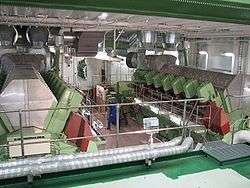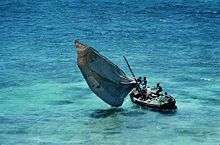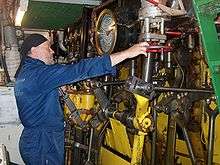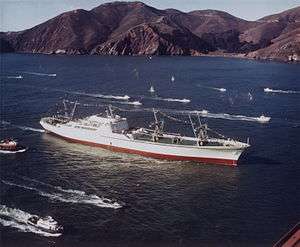Marine propulsion

Marine propulsion is the mechanism or system used to generate thrust to move a ship or boat across water. While paddles and sails are still used on some smaller boats, most modern ships are propelled by mechanical systems consisting of an electric motor or engine turning a propeller, or less frequently, in pump-jets, an impeller. Marine engineering is the discipline concerned with the engineering design process of marine propulsion systems.
Marine steam engines were the first mechanical engines used in marine propulsion, however they have mostly been replaced by two-stroke or four-stroke diesel engines, outboard motors, and gas turbine engines on faster ships. Nuclear reactors producing steam are used to propel warships and icebreakers. Nuclear reactors to power commercial vessels has not been adopted by the marine industry. Electric motors using electric battery storage have been used for propulsion on submarines and electric boats and have been proposed for energy-efficient propulsion.[1] Development in liquefied natural gas (LNG) fueled engines are gaining recognition for their low emissions and cost advantages. Stirling engines, which are more efficient, quieter, smoother running producing less harmful emissions than diesel engines, propel a number of small submarines. The Stirling engine has yet to be upscaled for larger surface ships.
Power sources
Pre-mechanisation

Until the application of the coal-fired steam engine to ships in the early 19th century, oars or the wind were used to assist watercraft propulsion. Merchant ships predominantly used sail, but during periods when naval warfare depended on ships closing to ram or to fight hand-to-hand, galley were preferred for their manoeuvrability and speed. The Greek navies that fought in the Peloponnesian War used triremes, as did the Romans at the Battle of Actium. The development of naval gunnery from the 16th century onward meant that manoeuvrability took second place to broadside weight; this led to the dominance of the sail-powered warship over the following three centuries.
In modern times, human propulsion is found mainly on small boats or as auxiliary propulsion on sailboats. Human propulsion includes the push pole, rowing, and pedals.
Propulsion by sail generally consists of a sail hoisted on an erect mast, supported by stays, and controlled by lines made of rope. Sails were the dominant form of commercial propulsion until the late nineteenth century, and continued to be used well into the twentieth century on routes where wind was assured and coal was not available, such as in the South American nitrate trade. Sails are now generally used for recreation and racing, although innovative applications of kites/royals, turbosails, rotorsails, wingsails, windmills and SkySails's own kite buoy-system have been used on larger modern vessels for fuel savings.
Reciprocating steam engines

The development of piston-engined steamships was a complex process. Early steamships were fueled by wood, later ones by coal or fuel oil. Early ships used stern or side paddle wheels, while later ones used screw propellers.
The first commercial success accrued to Robert Fulton's North River Steamboat (often called Clermont) in US in 1807, followed in Europe by the 45-foot Comet of 1812. Steam propulsion progressed considerably over the rest of the 19th century. Notable developments include the steam surface condenser, which eliminated the use of sea water in the ship's boilers. This, along with improvements in boiler technology, permitted higher steam pressures, and thus the use of higher efficiency multiple expansion (compound) engines. As the means of transmitting the engine's power, paddle wheels gave way to more efficient screw propellers.
Steam turbines
Steam turbines were fueled by coal or, later, fuel oil or nuclear power. The marine steam turbine developed by Sir Charles Algernon Parsons[2] raised the power-to-weight ratio. He achieved publicity by demonstrating it unofficially in the 100-foot Turbinia at the Spithead Naval Review in 1897. This facilitated a generation of high-speed liners in the first half of the 20th century, and rendered the reciprocating steam engine obsolete; first in warships, and later in merchant vessels.
In the early 20th century, heavy fuel oil came into more general use and began to replace coal as the fuel of choice in steamships. Its great advantages were convenience, reduced manpower by removal of the need for trimmers and stokers, and reduced space needed for fuel bunkers.
In the second half of the 20th century, rising fuel costs almost led to the demise of the steam turbine. Most new ships since around 1960 have been built with diesel engines. The last major passenger ship built with steam turbines was the Fairsky, launched in 1984. Similarly, many steam ships were re-engined to improve fuel efficiency. One high-profile example was the 1968 built Queen Elizabeth 2 which had her steam turbines replaced with a diesel-electric propulsion plant in 1986.
Most new-build ships with steam turbines are specialist vessels such as nuclear-powered vessels, and certain merchant vessels (notably Liquefied Natural Gas (LNG) and coal carriers) where the cargo can be used as bunker fuel.
LNG carriers
New LNG carriers (a high growth area of shipping) continue to be built with steam turbines. The natural gas is stored in a liquid state in cryogenic vessels aboard these ships, and a small amount of 'boil off' gas is needed to maintain the pressure and temperature inside the vessels within operating limits. The 'boil off' gas provides the fuel for the ship's boilers, which provide steam for the turbines, the simplest way to deal with the gas. Technology to operate internal combustion engines (modified marine two-stroke diesel engines) on this gas has improved, however, such engines are starting to appear in LNG carriers; with their greater thermal efficiency, less gas is burnt. Developments have also been made in the process of re-liquifying 'boil off' gas, letting it be returned to the cryogenic tanks. The financial returns on LNG are potentially greater than the cost of the marine-grade fuel oil burnt in conventional diesel engines, so the re-liquefaction process is starting to be used on diesel engine propelled LNG carriers. Another factor driving the change from turbines to diesel engines for LNG carriers is the shortage of steam turbine qualified seagoing engineers. With the lack of turbine powered ships in other shipping sectors, and the rapid rise in size of the worldwide LNG fleet, not enough have been trained to meet the demand. It may be that the days are numbered for marine steam turbine propulsion systems, even though all but sixteen of the orders for new LNG carriers at the end of 2004 were for steam turbine propelled ships.[3]

Nuclear-powered steam turbines
In these vessels, the nuclear reactor heats water to create steam to drive the turbines. Due to low prices of diesel oil, nuclear propulsion is rare except in some Navy and specialist vessels such as icebreakers. In large aircraft carriers, the space formerly used for ship's bunkerage could be used instead to bunker aviation fuel. In submarines, the ability to run submerged at high speed and in relative quiet for long periods holds obvious advantages. A few cruisers have also employed nuclear power; as of 2006, the only ones remaining in service are the Russian Kirov class. An example of a non-military ship with nuclear marine propulsion is the Arktika class icebreaker with 75,000 shaft horsepower (55,930 kW). Commercial experiments such as the NS Savannah have so far proved uneconomical compared with conventional propulsion.
In recent times, there is some renewed interest in commercial nuclear shipping. Nuclear-powered cargo ships could lower costs associated with carbon dioxide emissions and travel at higher cruise speeds than conventional diesel powered vessels.[4]
Reciprocating diesel engines
Most modern ships use a reciprocating diesel engine as their prime mover, due to their operating simplicity, robustness and fuel economy compared to most other prime mover mechanisms. The rotating crankshaft can be directly coupled to the propeller with slow speed engines, via a reduction gearbox for medium and high speed engines, or via an alternator and electric motor in diesel-electric vessels. The rotation of the crankshaft is connected to the camshaft or a hydraulic pump on an intelligent diesel.
The reciprocating marine diesel engine first came into use in 1903 when the diesel electric rivertanker Vandal was put into service by Branobel. Diesel engines soon offered greater efficiency than the steam turbine, but for many years had an inferior power-to-space ratio. The advent of turbocharging however hastened their adoption, by permitting greater power densities.
Diesel engines today are broadly classified according to
- Their operating cycle: two-stroke engine or four-stroke engine
- Their construction: crosshead, trunk, or opposed piston
- Their speed
- Slow speed: any engine with a maximum operating speed up to 300 revolutions per minute (rpm), although most large two-stroke slow speed diesel engines operate below 120 rpm. Some very long stroke engines have a maximum speed of around 80 rpm. The largest, most powerful engines in the world are slow speed, two stroke, crosshead diesels.
- Medium speed: any engine with a maximum operating speed in the range 300-900 rpm. Many modern four-stroke medium speed diesel engines have a maximum operating speed of around 500 rpm.
- High speed: any engine with a maximum operating speed above 900 rpm.

Most modern larger merchant ships use either slow speed, two stroke, crosshead engines, or medium speed, four stroke, trunk engines. Some smaller vessels may use high speed diesel engines.
The size of the different types of engines is an important factor in selecting what will be installed in a new ship. Slow speed two-stroke engines are much taller, but the footprint required is smaller than that needed for equivalently rated four-stroke medium speed diesel engines. As space above the waterline is at a premium in passenger ships and ferries (especially ones with a car deck), these ships tend to use multiple medium speed engines resulting in a longer, lower engine room than that needed for two-stroke diesel engines. Multiple engine installations also give redundancy in the event of mechanical failure of one or more engines, and the potential for greater efficiency over a wider range of operating conditions.
As modern ships' propellers are at their most efficient at the operating speed of most slow speed diesel engines, ships with these engines do not generally need gearboxes. Usually such propulsion systems consist of either one or two propeller shafts each with its own direct drive engine. Ships propelled by medium or high speed diesel engines may have one or two (sometimes more) propellers, commonly with one or more engines driving each propeller shaft through a gearbox. Where more than one engine is geared to a single shaft, each engine will most likely drive through a clutch, allowing engines not being used to be disconnected from the gearbox while others keep running. This arrangement lets maintenance be carried out while under way, even far from port.
LNG Engines
Shipping companies are required to comply with the International Maritime Organization (IMO) and the International Convention for the Prevention of Pollution from Ships emissions rules. Dual fuel engines are fueled by either marine grade diesel, heavy fuel oil, or liquefied natural gas (LNG). A Marine LNG Engine has multiple fuel options, allowing vessels to transit without relying on one type of fuel. Studies show that LNG is the most efficient of fuels, although limited access to LNG fueling stations limits the production of such engines. Vessels providing services in the LNG industry have been retrofitted with dual-fuel engines, and have been proved to be extremely effective. Benefits of dual-fuel engines include fuel and operational flexibility, high efficiency, low emissions, and operational cost advantages. Liquefied natural gas engines offer the marine transportation industry with an environmentally friendly alternative to provide power to vessels. In 2010, STX Finland and Viking Line signed an agreement to begin construction on what would be the largest environmentally friendly cruise ferry. Construction of NB 1376 will be completed in 2013. According to Viking Line, vessel NB 1376 will primarily be fueled by liquefied natural gas. Vessel NB 1376 nitrogen oxide emissions will be almost zero, and sulphur oxide emissions will be at least 80% below the International Maritime Organization’s (IMO) standards. Company profits from tax cuts and operational cost advantages has led to the gradual growth of LNG fuel use in engines. [5]
Gas turbines
| Combined marine propulsion |
|---|
|
CODOG |
Many warships built since the 1960s have used gas turbines for propulsion, as have a few passenger ships, like the jetfoil. Gas turbines are commonly used in combination with other types of engine. Most recently, the RMS Queen Mary 2 has had gas turbines installed in addition to diesel engines. Because of their poor thermal efficiency at low power (cruising) output, it is common for ships using them to have diesel engines for cruising, with gas turbines reserved for when higher speeds are needed. However, in the case of passenger ships the main reason for installing gas turbines has been to allow a reduction of emissions in sensitive environmental areas or while in port.[6] Some warships, and a few modern cruise ships have also used steam turbines to improve the efficiency of their gas turbines in a combined cycle, where waste heat from a gas turbine exhaust is utilized to boil water and create steam for driving a steam turbine. In such combined cycles, thermal efficiency can be the same or slightly greater than that of diesel engines alone; however, the grade of fuel needed for these gas turbines is far more costly than that needed for the diesel engines, so the running costs are still higher.
Stirling engines
Since the late 1980s, Swedish shipbuilder Kockums has built a number of successful Stirling engine powered submarines.[7][8] The submarines store compressed oxygen to allow more efficient and cleaner external fuel combustion when submerged, providing heat for the Stirling engine's operation. The engines are currently used on submarines of the Gotland and Södermanland classes. and the Japanese Sōryū-class submarine.[9] These are the first submarines to feature Stirling air-independent propulsion (AIP), which extends the underwater endurance from a few days to several weeks.[8]
The heat sink of a Stirling engine is typically the ambient air temperature. In the case of medium to high power Stirling engines, a radiator is generally required to transfer the heat from the engine to the ambient air. Stirling marine engines have the advantage of using the ambient temperature water. Placing the cooling radiator section in seawater rather than ambient air allows for the radiator to be smaller. The engine's cooling water may be used directly or indirectly for heating and cooling purposes of the ship. The Stirling engine has potential for surface-ship propulsion, as the engine's larger physical size is less of a concern.
Screws
Marine propellers are also known as "screws". There are many variations of marine screw systems, including twin, contra-rotating, controllable-pitch, and nozzle-style screws. While smaller vessels tend to have a single screw, even very large ships such as tankers, container ships and bulk carriers may have single screws for reasons of fuel efficiency. Other vessels may have twin, triple or quadruple screws. Power is transmitted from the engine to the screw by way of a propeller shaft, which may or may not be connected to a gearbox.
Paddle wheels

Right: detail of a paddle steamer.
The paddle wheel is a large wheel, generally built of a steel framework, upon the outer edge of which are fitted numerous paddle blades (called floats or buckets). The bottom quarter or so of the wheel travels underwater. Rotation of the paddle wheel produces thrust, forward or backward as required. More advanced paddle wheel designs have featured feathering methods that keep each paddle blade oriented closer to vertical while it is in the water; this increases efficiency. The upper part of a paddle wheel is normally enclosed in a paddlebox to minimise splashing.
Paddle wheels have been superseded by screws, which are a much more efficient form of propulsion. Nevertheless, paddle wheels have two advantages over screws, making them suitable for vessels in shallow rivers and constrained waters: first, they are less likely to be clogged by obstacles and debris; and secondly, when contra-rotating, they allow the vessel to spin around its own vertical axis. Some vessels had a single screw in addition to two paddle wheels, to gain the advantages of both types of propulsion.
Sailing
The purpose of sails is to use wind energy to propel the vessel, sled, board, vehicle or rotor.
Water caterpillar

An early uncommon means of boat propulsion was the water caterpillar. This moved a series of paddles on chains along the bottom of the boat to propel it over the water and preceded the development of tracked vehicles.[10] The first water caterpillar was developed by Desblancs in 1782 and propelled by a steam engine. In the United States the first water caterpillar was patented in 1839 by William Leavenworth of New York.
Buoyancy
Underwater gliders convert buoyancy to thrust, using wings, or more recently hull shape (SeaExplorer Glider). Buoyancy is made alternatively negative and positive, generating tooth-saw profiles.
See also
- Experiment (horse-powered boat)
- Non-road engine
- Wind assisted propulsion
- Nuclear marine propulsion
- Internal drive propulsion
- Integrated electric propulsion
- Combined nuclear and steam propulsion
- Astern propulsion
- Air-independent propulsion
References
| Wikimedia Commons has media related to Marine propulsion. |
- ↑ http://www.ivt.ntnu.no/imt/electricship/
- ↑ A Stodola (1927) Steam and Gas Trubines. McGraw-Hill.
- ↑ "informare - Forum of Shipping and Logistics". Informare.it. Retrieved 2009-04-21.
- ↑ "Full steam ahead for nuclear shipping". World Nuclear News. 2010-11-18. Retrieved 2011-02-22.
- ↑ LNG World News. (2010) STX Finland and Viking Line sign agreement for cruise ferry. Retrieved December 15, 2011 from http://www.lngworldnews.com/stx-finland-and-viking-line-sign-agreement-for-cruise-ferry/ Wärtsilä. (2011) Wärtsilä dual-fuel power plants. Power plants. Retrieved December 15, 2011, from http://wartsila.com/en/power-plants/smart-power-generation/dual-fuel-power-plants Viking Line. (2011) LNG is our choice. Environment. Retrieved December 15, 2011, from www.nb1376.com
- ↑ "Return of the turbine - Cruise Travel". FindArticles.com. 2004-07-01. Retrieved 2009-04-21.
- ↑ "The Kockums Stirling AIP system – proven in operational service" (PDF). Kockums. Retrieved 2011-06-07.
- 1 2 Kockums (a)
- ↑ "First Improved Oyashio-class boat takes to the water". IHS. June 12, 2007. Archived from the original on 7 June 2011. Retrieved June 3, 2011.
- ↑ The Caterpillar Is Now Being Applied to Ships, Popular Science monthly, December 1918, page 68, Scanned by Google Books: https://books.google.com/books?id=EikDAAAAMBAJ&pg=PA68